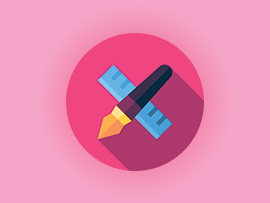Today, World fast growing with digital skills, Every Business and Service have one logo and unique design for his firm, By using design materials they can sell and display product and services. Take the next step on your graphic design journey. With these ICT Skills one to one live classes, you can explore a wide range of topics, tools, techniques and principles to become a stronger designer and improve your graphic design portfolio. Whether you’re an experienced professional or you’re looking for graphic design for beginners, you can take your skills to the next level with online classes in typography, color, design trends, logo design, custom font design, hand lettering, illustration, and beyond, all taught by talented graphic designers and working professionals.
You can learn how to use graphic design software like Adobe Photoshop, Illustrator, Canva, CorelDRAW and InDesign, and you’ll get hands-on experience by completing and sharing your own graphic design projects. ICT Skills offers job-oriented courses to help you build successful careers in the design areas. Join our graphic design courses to discover more about graphic design! With the rapid expansion of the Internet, the demand for skilled graphic designers is on the upswing and this number is only set to rise in the coming years.Enroll today and Get Job or make stunning portfolio of your designs.
ICT Skills One-to-one online graphic design training is a personalized, instructor-led learning experience where you receive undivided attention from an experienced graphic design tutor. Unlike traditional classroom settings or group workshops, one-to-one training allows for tailored lessons based on your goals, skill level, and learning pace. With the flexibility of online platforms, you can access high-quality training from anywhere in the world, without the constraints of location or a rigid schedule.
Why Choose One-to-One Graphic Design Training?
- Personalized Curriculum Every student has unique needs and goals. One-to-one online graphic design lessons are specifically designed to meet your personal learning objectives. Whether you’re a complete beginner wanting to learn the basics or an advanced designer refining your techniques, the curriculum is adapted to your pace and preferences.
- Learn from Experts One of the major advantages of one-to-one online graphic design training is the access to seasoned professionals who bring real-world design experience. These experts can provide personalized feedback, tips, and insights that go beyond what you’d typically find in self-paced or group courses.
- Flexible Scheduling Traditional classes often require you to work around fixed schedules. With one-to-one online training, you have the flexibility to schedule your sessions based on your availability. Whether you have a busy work schedule or prefer learning in the evenings, you can find a time that works for you.
- Real-Time Feedback Unlike pre-recorded tutorials, one-to-one training allows you to ask questions in real time and receive immediate feedback. This interactive learning environment ensures that you don’t just watch the lessons but fully understand the material and can apply it right away.
- Custom Design Projects As you progress, you’ll work on real-world projects that are tailored to your specific interests. This hands-on approach ensures you can immediately apply your skills to projects that matter to you, whether it’s creating logos, brochures, social media designs, or even branding kits.
Key Skills You’ll Learn
In a one-to-one online graphic design training session, you’ll acquire a variety of essential design skills, including:
- Software Proficiency: Master industry-standard tools like Adobe Photoshop, Illustrator, InDesign, and other design software. Whether you’re new to these tools or looking to deepen your knowledge, your instructor will guide you through every feature.
- Principles of Design: Learn foundational principles like color theory, typography, composition, and layout. These principles are critical for creating visually engaging and effective designs.
- Creative Thinking and Problem-Solving: Graphic design isn’t just about technical skills. You’ll also develop your creativity, learning how to approach design challenges with innovative solutions.
- Branding and Identity Design: Understand how to create cohesive visual identities, from logos to full brand guidelines, and apply your design skills to help businesses communicate their values and vision.
- User-Centered Design: Discover the importance of designing with the audience in mind. Learn how to create designs that resonate with users and deliver an intuitive experience.
Advantages of Learning Graphic Design Online
- Convenience and Comfort: Study from the comfort of your own home, eliminating the need to commute or attend in-person sessions. All you need is a computer and an internet connection to start learning.
- Access to Global Experts: With online learning, you’re not limited to local instructors. You can connect with graphic design experts from around the world, gaining access to diverse perspectives and teaching styles.
Our one-to-one online graphic design training offers a unique and effective way to build your design skills, whether you’re starting from scratch or looking to refine your craft. With personalized lessons, expert guidance, and the flexibility to learn at your own pace, it’s the perfect solution for those serious about pursuing a career in graphic design or enhancing their creative skills. Start your journey today, and unlock your potential as a graphic designer.
Course Features
- Lectures 0
- Quizzes 0
- Duration 18 weeks
- Skill level All levels
- Language English, Gujarati, Hindi
- Students 9
- Assessments Self
Curriculum
- 9 Sections
- 0 Lessons
- 18 Weeks
Expand all sectionsCollapse all sections
- Introduction to Graphic Design0
- CorelDRAW0
- Photoshop0
- illustrator0
- InDesign0
- Publisher0
- Canva0
- Portfolio Development0
- Interview Preparation0
Graphic design training is a learning program designed to teach you the principles and techniques of graphic design. This training covers various aspects of design, including software skills, typography, color theory, branding, and visual communication. It can be done through online courses or one-to-one lessons.
The industry-standard graphic design software includes:
Adobe Photoshop: For photo editing and digital artwork.
Adobe Illustrator: For vector-based designs like logos and illustrations.
Adobe InDesign: For page layout design, such as brochures and magazines.
CorelDRAW: An alternative to Illustrator, often used for vector graphics.
No, you do not need to be a skilled hand-drawn artist to become a graphic designer. While drawing can enhance your creativity, graphic design is more about visual communication, using design software to create effective and engaging content. Many designers focus on layout, typography, color, and composition rather than hand-drawing.
Design principles: Understanding balance, contrast, alignment, and hierarchy.
Typography: Learning how to choose and arrange fonts for maximum readability and visual impact.
Color theory: Understanding how colors interact and affect emotions and readability.
Software proficiency: Mastering design software like Adobe Creative Suite, Figma, or Sketch.
Branding: Creating logos, brand guidelines, and identity systems for businesses.
Digital and print design: Learning the nuances of designing for both digital screens and physical media.
Creative problem-solving: Approaching design challenges with fresh, innovative solutions.
Graphic Design Training FAQs
Whether you're just starting or looking to refine your skills, graphic design training can open up many doors for creativity and career advancement. Here are some of the most common questions people have about graphic design training.
1. What is graphic design training?
Graphic design training is a learning program designed to teach you the principles and techniques of graphic design. This training covers various aspects of design, including software skills, typography, color theory, branding, and visual communication. It can be done through online courses, in-person classes, or one-to-one lessons.
2. What are the different types of graphic design training?
Self-paced courses: These are typically pre-recorded video lessons that you can watch at your own convenience.
Instructor-led courses: These offer live classes with an experienced instructor who provides real-time feedback.
One-to-one training: Personalized, one-on-one sessions with an instructor, allowing you to learn at your own pace and focus on your specific goals.
Boot camps and workshops: Intensive, short-term programs designed to teach specific skills or software in a concentrated timeframe.
3. What software do I need to learn for graphic design?
The industry-standard graphic design software includes:
Adobe Photoshop: For photo editing and digital artwork.
Adobe Illustrator: For vector-based designs like logos and illustrations.
Adobe InDesign: For page layout design, such as brochures and magazines.
Sketch or Figma: For web and UI design.
CorelDRAW: An alternative to Illustrator, often used for vector graphics.
Most graphic design training programs will teach you to use these tools, but you may choose to specialize in one or two based on your interests.
4. Do I need to be good at drawing to become a graphic designer?
No, you do not need to be a skilled hand-drawn artist to become a graphic designer. While drawing can enhance your creativity, graphic design is more about visual communication, using design software to create effective and engaging content. Many designers focus on layout, typography, color, and composition rather than hand-drawing.
5. What skills will I learn in graphic design training?
Some of the key skills taught in graphic design training include:
Design principles: Understanding balance, contrast, alignment, and hierarchy.
Typography: Learning how to choose and arrange fonts for maximum readability and visual impact.
Color theory: Understanding how colors interact and affect emotions and readability.
Software proficiency: Mastering design software like Adobe Creative Suite, Figma, or Sketch.
Branding: Creating logos, brand guidelines, and identity systems for businesses.
Digital and print design: Learning the nuances of designing for both digital screens and physical media.
Creative problem-solving: Approaching design challenges with fresh, innovative solutions.
6. Can I learn graphic design online?
Yes, many graphic design programs are available online. Online training provides flexibility and the opportunity to learn at your own pace, often with personalized options such as one-to-one lessons with experienced instructors. Online platforms offer a variety of learning materials, including video tutorials, reading materials, assignments, and live sessions.
7. How long does it take to learn graphic design?
The time it takes to learn graphic design varies depending on your goals, the type of training, and how much time you can dedicate to practice. If you're learning part-time, basic design skills may take anywhere from 3 to 6 months to grasp. If you aim to become proficient in advanced skills and software, it may take 1-2 years of focused learning. Many online courses offer flexible timelines, so you can learn at your own pace.
8. Is graphic design a good career choice?
Yes! Graphic design is a highly versatile and rewarding career. With the rise of digital media, demand for skilled designers continues to grow across many industries, including advertising, marketing, web design, game design, branding, and more.
Graphic Designer: Creating visual concepts for print, digital media, and marketing.
Web Designer: Specializing in designing websites and user interfaces.
UX/UI Designer: Focusing on the design and usability of digital products.
Brand Designer: Developing brand identities, including logos and visual guidelines.
Illustrator: Creating original artwork for digital or print media.
Freelance Designer: Working independently with clients across industries.
Creative Director: Leading design teams and overseeing large design projects.
To build a strong portfolio:
Include a variety of work: Showcase different types of design such as logos, posters, websites, and branding projects.
Focus on quality, not quantity: Include only your best work.
Show process work: Include sketches, wireframes, or explanations of your design process to show how you solve problems.
Continuously update your portfolio as you gain more experience and skills.

